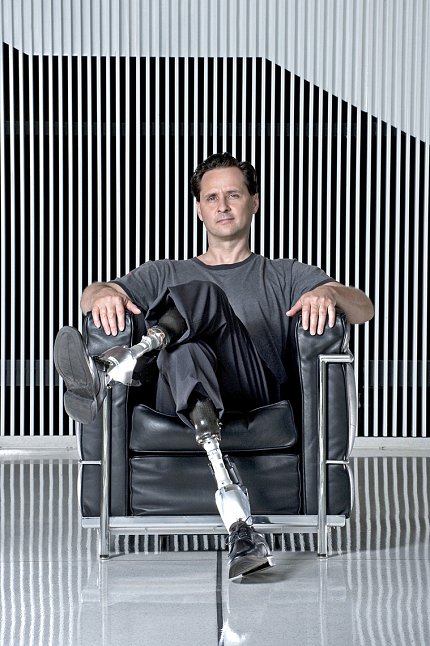‘EmPower’
AMI Technique Gives New Life to Amputees

Photo: matthew septimus
Hugh Herr was an accomplished young mountain climber when he suffered what should have been a career-ending accident. Both lower legs had to be amputated below the knee. Rather than end his climbing career, though, it inspired him to craft specialized prostheses that allowed him to climb even better than before. His interest in prostheses led him to a career in bionic limb design. Herr is currently a professor at MIT, directing the biomechatronics research group and co-directing the MIT Center for Extreme Bionics.
Herr describes bionics as “this glorious interplay between biology and engineering design” and utilizes this interplay in the research that has produced his current legs (and the legs that have given new life to many other amputees): “EmPower.”
In his recent Wednesday Afternoon Lecture Series presentation, “On the Design of Bionic Limbs: The Science of Tissue-Synthetic Interface,” Herr spoke about a new surgical technique developed by his lab that allows for direct communication between the nervous system and bionic prostheses like EmPower.
Up until very recently, amputation surgeries were what Herr referred to as “Civil War-era amputations.” The limb was removed with little thought as to how it would interact with a prosthetic device. Herr saw a way to improve this system, namely, by linking a bionic–computer-powered–limb to the wearer’s nervous system. He calls it “neuro-embodied design,” or, a way to “co-design the biological body with [a] synthetic construct to maximize bi-directional communication between the device and the human nervous system.” In other words: a computer-powered bionic limb can both send and receive electrical signals to and from the wearer’s nervous system.
The Civil War surgeries that Herr described remove limbs with little regard for the musculature at the end of the appendage. In 2015, he and his colleagues devised a new surgery: agonist-antagonist myoneural interface (AMI).
Muscles typically work in groups of two to move an appendage: the antagonist is stretched as the agonist contracts. Typically, the agonist muscle contracts when it receives an electrical signal from the central nervous system (CNS). The connections between many agonist-antagonist groups are often severed in the old amputation method, but AMI reconnects these pairs (native) and/or builds new ones (regenerative).

Artificial muscle electrodes are placed on each AMI pair and communicate with computers within the bionic limb. When the agonist muscle contracts due to electrical activation (from the CNS or prosthetic computer), that contraction stretches the antagonist muscle, and these dynamics are communicated to the CNS, giving the person a sense of muscle length, speed and force. This sense is known as proprioception, or awareness of the position and movement of the body. It’s absent or much diminished in patients who did not undergo the AMI procedure.
Conversely, amputees who received AMI feel the motion of their bionic limbs, and can also move them in natural, reflexive ways.
Herr is also conducting trials to improve prosthetic technology further. The studies involve implanting magnetic beads into AMI muscle pairs to allow the bionic limb’s computers to better track muscle contractions, and linking cutaneous (skin) nerves to the limb to replicate the sensation of touch.
He ended his lecture with a video of an AMI recipient returning to the site of his accident, where he completed his climb with his bionic limb.
“Human beings aren’t broken; they aren’t weak; they aren’t disabled,” Herr concluded. “The technology is weak and disabled and broken. [We should] always strive for better and better rehabilitation and assistive technology interventions, with the long-term goal of dramatically mitigating or even eliminating disability.”
